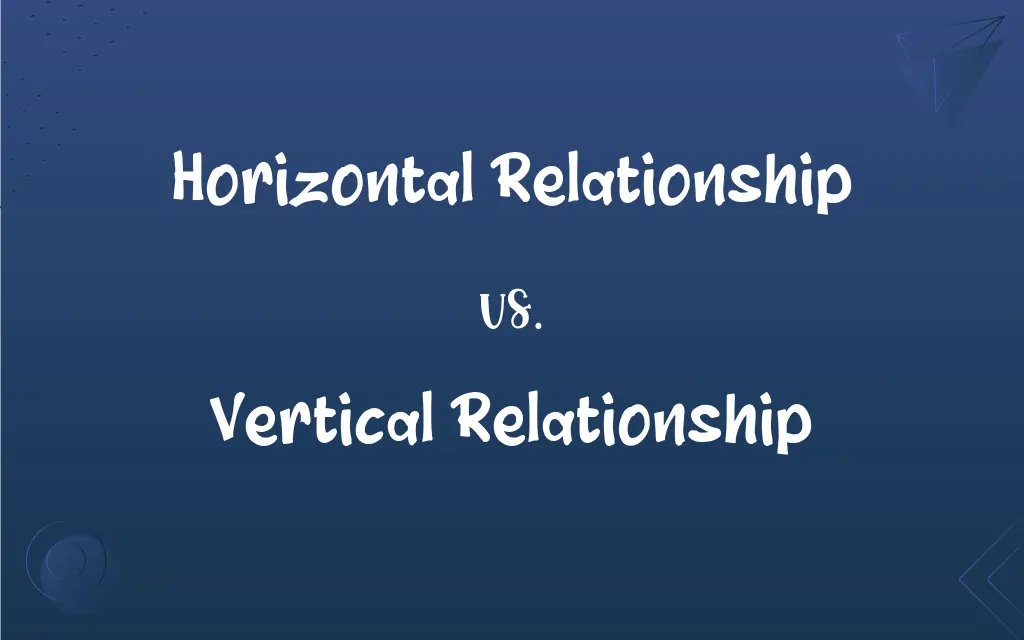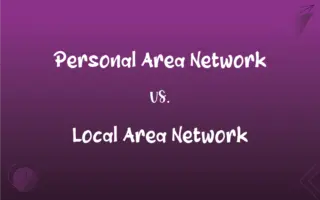Horizontal Relationship vs. Vertical Relationship: What's the Difference?
Edited by Harlon Moss || By Janet White || Published on March 30, 2024
Horizontal relationships are interactions between equals, typically among peers or departments. Vertical relationships are hierarchical, involving authority levels, such as between managers and employees.

Key Differences
Horizontal relationships refer to the interactions that occur between individuals, teams, or departments operating at the same level within an organization or social structure. These relationships are characterized by a collaborative and cooperative approach, aiming to facilitate communication, share resources, and align goals across different segments without a direct authority gradient. Vertical relationships, in contrast, are defined by a clear hierarchy and involve individuals or groups at different levels of an organization's structure. This type of relationship is based on authority, supervision, and subordination, where directives flow from higher to lower levels, such as from executives to managers, and from managers to employees.
The dynamic between horizontal and vertical relationships is fundamental to the operational efficiency and cultural health of any organization. Horizontal relationships enhance mutual respect and understanding among colleagues, encouraging a more engaged and collaborative workforce. This lateral communication is vital for breaking down silos, facilitating innovation, and adapting to changes rapidly. Conversely, vertical relationships ensure that the organization's vision and objectives are clearly defined and pursued, with leaders guiding their teams towards achieving set goals, providing feedback, and making critical decisions.
An organization's ability to balance horizontal and vertical relationships directly impacts its agility, culture, and performance. Effective horizontal relationships can lead to a more flexible and adaptive organization, while strong vertical relationships provide the necessary structure and direction. However, an overemphasis on vertical relationships may stifle creativity and inhibit open communication, whereas an exclusive focus on horizontal relationships might lead to a lack of clear direction and decision-making authority.
Both horizontal and vertical relationships are vital for different reasons. Horizontal relationships promote collaboration, equality, and shared objectives among peers, whereas vertical relationships establish a framework of authority, responsibility, and hierarchical communication. The most successful organizations are those that manage to harness the strengths of both types of relationships, creating an environment where innovation is encouraged, and strategic goals are effectively pursued.
Comparison Chart
Structure
Equal level, among peers or departments
Hierarchical, across different levels of authority
ADVERTISEMENT
Communication Flow
Lateral, among equals
Top-down or bottom-up, through levels of hierarchy
Purpose
Collaboration, sharing resources, innovation
Direction, order, implementing strategic decisions
Key Features
Equality, teamwork, cross-functional collaboration
Authority, leadership, structured progression of tasks
Impact on Organization
Promotes flexibility, breaks down silos
Provides clear direction, ensures accountability
Horizontal Relationship and Vertical Relationship Definitions
Horizontal Relationship
Exchanging information among peers.
Horizontal relationships facilitate open dialogue within our peer group.
ADVERTISEMENT
Vertical Relationship
Assigning responsibilities from higher to lower levels.
The workflow is streamlined through the vertical relationships between management and staff.
Horizontal Relationship
Teams composed of members from different departments.
Our project's success was due to effective horizontal relationships across functions.
Vertical Relationship
Strategic decisions made at the top.
In our vertical relationships, executives make the final calls on major projects.
Horizontal Relationship
Interaction among colleagues at the same level.
In our team, we rely on horizontal relationships to brainstorm ideas.
Vertical Relationship
Directives given by leaders to subordinates.
Vertical relationships ensure that the company's vision is clearly communicated to all levels.
Horizontal Relationship
Cooperation between departments without direct authority.
Horizontal relationships between sales and marketing enhance our strategy.
Vertical Relationship
Reviews conducted by superiors.
Annual performance reviews are a key aspect of our vertical relationship.
Horizontal Relationship
Collaborating on equal footing to find solutions.
Through horizontal relationships, we developed a groundbreaking product.
Vertical Relationship
The dynamic between a supervisor and their employee.
Our manager's guidance exemplifies the vertical relationship in our department.
FAQs
Can an organization have both horizontal and vertical relationships?
Yes, successful organizations often integrate both to balance flexibility and structure.
What is a horizontal relationship?
It's an interaction among individuals or groups at the same organizational level.
What is the purpose of vertical relationships?
They provide structure, direction, and facilitate the implementation of decisions.
How do horizontal relationships benefit an organization?
They promote collaboration, innovation, and break down silos.
How do horizontal relationships affect communication?
They encourage open and equal communication among peers.
What role do vertical relationships play in decision-making?
They ensure decisions are made with authority and are communicated down the hierarchy.
How can an organization foster healthy horizontal relationships?
By promoting teamwork, cross-functional projects, and open communication.
Can vertical relationships hinder innovation?
If overly rigid, yes, they can stifle creativity and flexibility.
What is a vertical relationship?
It's a hierarchical interaction between individuals or groups at different levels of authority.
Are horizontal relationships more important than vertical ones?
Both are essential for different reasons; balance is key.
What strategies enhance vertical relationships?
Clear communication of goals, regular feedback, and defined leadership roles.
How can horizontal relationships improve team performance?
By fostering a sense of equality and collaboration, enhancing problem-solving and innovation.
What challenges come with horizontal relationships?
Potential for conflict without clear decision-making authority.
How do vertical relationships impact employee motivation?
They can either motivate through clear direction and feedback or demotivate if too controlling.
Is it easier to establish horizontal or vertical relationships?
It depends on the organization's structure and culture.
How do startups typically manage these relationships?
Startups may emphasize horizontal relationships for flexibility and innovation.
How do horizontal relationships help in managing change?
They facilitate rapid sharing of information and collaborative adaptation to change.
How can a balance between horizontal and vertical relationships be achieved?
Through leadership that values both collaboration and clear direction.
Do horizontal or vertical relationships require more effort to maintain?
Both require effort, but in different ways—horizontal for equality, vertical for hierarchy management.
What impact do vertical relationships have on organizational culture?
They can establish clear leadership and accountability, shaping the culture.
About Author
Written by
Janet WhiteJanet White has been an esteemed writer and blogger for Difference Wiki. Holding a Master's degree in Science and Medical Journalism from the prestigious Boston University, she has consistently demonstrated her expertise and passion for her field. When she's not immersed in her work, Janet relishes her time exercising, delving into a good book, and cherishing moments with friends and family.
Edited by
Harlon MossHarlon is a seasoned quality moderator and accomplished content writer for Difference Wiki. An alumnus of the prestigious University of California, he earned his degree in Computer Science. Leveraging his academic background, Harlon brings a meticulous and informed perspective to his work, ensuring content accuracy and excellence.































































